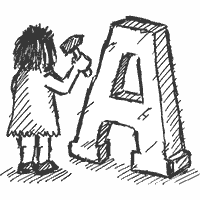You’ve heard of WordPress, right? Textpattern began around the same time and does much the same job. The difference? Our CMS is based around these key concepts:
- Just write
Site layout shouldn’t get in the way of content. - Tiny footprint
Because small is beautiful, elegant and fast. - Build only what you need
The core is powerful enough for most websites. Plugins extend this. - No need to code PHP
Flexible tags act as dynamic content placeholders in your site templates. If you recognise HTML, you’ll easily grasp Textpattern tags.
Content management first
Articles are the lifeblood of content. Title, Excerpt, Body text, Posted date and additional custom fields. Sprinkle images, links and file downloads and you have most of what you need to deliver a stunning website. A comments module is built-in and optional.
Articles are written in Textile – a human-friendly shortcut system, much like Markdown (which is also supported via a plugin) – and appear to website visitors in navigable sections like /blog, /services, and /contact. Filtering by category and author is simple, as is search to help people find your content.
Separate presentation layer
On the design front, Pages are your main, reusable templates that contain a mix of HTML furniture and Textpattern tags. Stylesheets bring in CSS rules that format the markup. When a visitor reaches /blog for example, Textpattern looks up which page and stylesheet to fetch and displays them. Every time it encounters a <txp:...> tag on that page, it fetches the relevant content from the database and replaces the tag with it.
There are tags for all occasions. Content tags, list tags, navigation tags, and conditional tags that allow you to take action if some condition is true (e.g. if a search is being performed, or if the article contains an excerpt).
The tags are incredibly powerful – most do what you expect with the minimum of fuss as they are context aware. Textpattern is smart enough to know that /blog/ is a section landing page that displays a list of articles in that section, whereas /blog/how-to-use-textpattern is an individual article. The <txp:article /> tag automatically reacts accordingly.
Reusable content snippets for even more power
Your templates can employ reusable snippets, called Forms, to help reduce long-term site maintenance. Offload repetitive markup like creating each entry in a list of articles, or rendering individual article components, and reuse them throughout your site for consistency. Should you wish to change their layout, simply alter them once and your entire site updates instantly.
If you want something not offered out of the box or wish to extend the built-in functionality, you may construct your own shortcode tags. For ultimate power, you can even use PHP if you wish, although you can create beautiful, standards-compliant sites without it.
Additional benefits
- Update your site without a staging server
Ongoing maintenance is simple, as development can safely take place directly on the live server using live data. - Responsive, helpful community
We are on-hand around the clock for support. - Admin area available in over 50 languages
Our army of volunteer translators work hard to ensure the interface is clean and easy to understand. - Multi-user environment
Assignable roles let your users focus on only the parts of the back-end system they need.
So what are you waiting for? Build your next website with Textpattern and join the thousands of folk that benefit from its power and simplicity. There’s a demo available to play with too.
We look forward to welcoming you.

